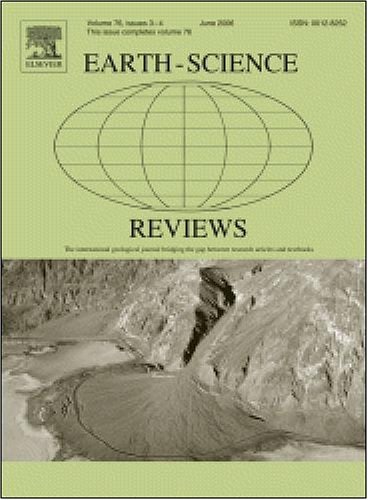亚洲北部高山地区中、晚更新世冰川作用的时间和范围
IF 10.8
1区 地球科学
Q1 GEOSCIENCES, MULTIDISCIPLINARY
引用次数: 0
摘要
亚洲高山地区(HMA)是中低纬度地区现代冰川最集中的地区。HMA地区广泛分布的冰川地貌表明,随着时间的推移,这些冰川的范围发生了重大变化。HMA北部气候主要受亚洲季风和中纬度西风带的影响。间冰期气候系统的变化可能导致HMA北部独特的冰川演化模式;然而,阐明这一模式需要对该地区冰川的时空演变有一个全面的认识。为了实现这一目标,我们编制了450个来自HMA北部的10Be暴露年龄,其中包括84个新的年龄和366个先前报道的年龄,我们还进行了与冰川地质记录相对应的古冰川范围的高分辨率模拟。我们的发现强调了整个HMA过去冰川演化的复杂性。两个气候域在冰川序列、气候机制、冰川样式和平衡线海拔(ELA)下降等方面具有相似之处。在这两个区域都发现了与海洋同位素阶段(MIS) 6、3和2相对应的冰川推进形成的地貌,表明这些进展与较冷的气候条件之间存在很强的关系。自第二次冰期以来,HMA北部冰川经历了从广阔的冰原到山前冰川、山谷冰川、环状冰川的演变过程。这种转变反映在欧洲经济联盟的逐步上升上。这两个气候区冰川演化的一个关键区别是,局部末次盛冰期(lLGM)的时间与全球末次盛冰期(gLGM)的时间不同步。季风-西风带过渡带和西风带过渡带的时间不同,分别发生在MIS 3和MIS 4。这种差异是由大气环流系统相对强度的变化和水汽供应的变化造成的。在同样凉爽的气候中,降水分布的变化解释了在过去的冰期循环中这两个气候域观测到的ELA变化的不同模式。本文章由计算机程序翻译,如有差异,请以英文原文为准。
Timing and extent of glaciation in northern High-Mountain Asia during the Middle and Late Pleistocene
High-Mountain Asia (HMA) hosts the largest concentration of modern glaciers in middle- and low-latitude regions. The widespread glacial landforms in HMA suggest that these glaciers have experienced significant changes in extent over time. The climate of northern HMA is influenced mainly by the Asian monsoons and the mid-latitude westerlies. Changes in the climate system during glacial-interglacial cycles potentially resulted in a unique pattern of glacial evolution in northern HMA; however, elucidating this pattern requires a comprehensive understanding of the spatiotemporal evolution of the glaciers in this region. To achieve this, we compiled 450 10Be exposure ages from northern HMA, including 84 new and 366 previously reported ages, and we also conducted high-resolution simulations of paleoglacier extent that correspond with glacial geological records. Our findings emphasize the complexity of past glacier evolution throughout HMA. The two climatic domains share similarities in glacial sequences, climatic mechanisms, glacial style, and depression of the equilibrium line altitude (ELA). Landforms created by glacier advances corresponding to Marine Isotope Stages (MIS) 6, 3, and 2 have been identified in both domains, indicating a strong relationship between these advances and cooler climatic conditions. Since the penultimate glaciation, glaciers in northern HMA have gradually evolved from extensive ice fields to piedmont glaciers, to valley glaciers, and then to cirque glaciers. This transformation is reflected in the progressive ascent of the ELA. A key difference in glacial evolution between these two climatic regions is that the timing of the local last glacial maximum (lLGM) was asynchronous compared to the global last glacial maximum (gLGM). The timing of the lLGM varied between the monsoons-westerlies transitional domain and the westerlies domain, occurring during MIS 3 and MIS 4, respectively. This difference was caused by variations in the relative strength of atmospheric circulation systems and changes in moisture supply. In a similarly cool climate, variations in precipitation distribution explain the differing patterns of ELA change observed in these two climate domains during past glacial cycles.
求助全文
通过发布文献求助,成功后即可免费获取论文全文。
去求助
来源期刊

Earth-Science Reviews
地学-地球科学综合
CiteScore
21.70
自引率
5.80%
发文量
294
审稿时长
15.1 weeks
期刊介绍:
Covering a much wider field than the usual specialist journals, Earth Science Reviews publishes review articles dealing with all aspects of Earth Sciences, and is an important vehicle for allowing readers to see their particular interest related to the Earth Sciences as a whole.
 求助内容:
求助内容: 应助结果提醒方式:
应助结果提醒方式:


